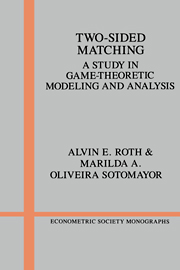Book contents
- Frontmatter
- Chapter 1 Introduction
- Part I One-to-one Matching: the Marriage Model
- Chapter 2 Stable matchings
- Chapter 3 The structure of the set of stable matchings
- Chapter 4 Strategic questions
- Part II Many-to-one matching: models in which firms may employ many workers
- Part III Models of one-to-one matching with money as a continuous variable
- Part IV Epilogue
- Bibliography
- Name Index
- Subject index
Chapter 2 - Stable matchings
from Part I - One-to-one Matching: the Marriage Model
Published online by Cambridge University Press: 05 January 2013
- Frontmatter
- Chapter 1 Introduction
- Part I One-to-one Matching: the Marriage Model
- Chapter 2 Stable matchings
- Chapter 3 The structure of the set of stable matchings
- Chapter 4 Strategic questions
- Part II Many-to-one matching: models in which firms may employ many workers
- Part III Models of one-to-one matching with money as a continuous variable
- Part IV Epilogue
- Bibliography
- Name Index
- Subject index
Summary
As in any game-theoretic analysis, it will be important in what follows to keep clearly in mind the “rules of the game” by which men and women may become married to one another, as these will influence every aspect of the analysis. (If, for example, our imaginary village were located in a country in which a young woman required the consent of her father before she could marry, then the fathers of eligible women would have a prominent role to play in the model.) We will suppose the general rules governing marriage are these: Any man and woman who both consent to marry one another may proceed to do so, and any man or woman is free to withhold his or her consent and remain single. We will consider more detailed descriptions of possible rules (concerning, e.g., how proposals are made, or whether a marriage broker plays a role) at various points in the discussion.
The formal (cooperative) model
The elements of the formal model are as follows. There are two finite and disjoint sets M and W: M = {mi m2, …,mn} is the set of men, and W= {w1, w2,..., wp} is the set of women. Each man has preferences over the women, and each woman has preferences over the men. These preferences may be such that, say, a man m would prefer to remain single rather than be married to some woman w he doesn't care for.
- Type
- Chapter
- Information
- Two-Sided MatchingA Study in Game-Theoretic Modeling and Analysis, pp. 17 - 53Publisher: Cambridge University PressPrint publication year: 1990



